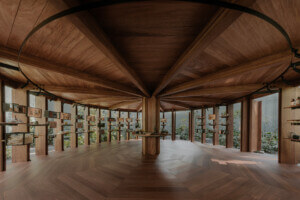When asked why he installed his latest public intervention at the Museo Espacio in Aguascalientes, Mexico, French artist Daniel Buren simply said, “Because I was invited.” But it is not difficult to see what makes the Museo Espacio and the larger Macro Espacio para la Cultura y las Artes (MECA) campus desirable for an international artist. Over the past five years the local government has been quietly developing one of the most intriguingly designed arts destinations in North America.
Many municipalities profess a dedication to the arts, but the government of the state of Aguascalientes, with assistance from Mexico’s federal government, has successfully implemented an ambitious master plan that transforms a century old rail yard into MECA, a world-class destination and center for the arts.
Carlos Lozano de la Torre, the governor of Aguascalientes, always viewed the revitalization of the rail yard as a cultural imperative. Established by an American railroad company in 1898, the 200-acre property was shut down by the government in 1991, effectively leaving Aguascalientes without any viable industry. Recognizing an opportunity for “regeneration through culture,” Governor de la Torre assembled a homegrown team including architect José Luis Jiménez García and Aguascalientes Cultural Institute director Dulce María Rivas Godoy to develop a master plan to stealthily transform the industrial structures into modern containers for the arts and connect the campus to the other established arts institutions in the small urban center.
Museo Espacio, one of the first buildings to open, is a generous 86,000-square-foot, intentionally barebones contemporary platform for international artists to display large-scale works of art. The former wood warehouse was revitalized with simple materials that nod to the building’s industrial history—polished concrete, steel, and glass—all seamlessly integrated into the long, wide bays often favored by conceptual artists. Rail tracks weave through the building and the site maintaining the balance between old and new. A custom metal screen wraps the exterior with monumental openings on either end.
In January, Museum Espacio opened with a site-specific installation by Jannis Kounellis, followed by a site-specific intervention by Buren, who has a long-standing relationship with Mexico. Buren’s work, titled Como un juego de nino, fills over 64,000 square feet, creating an exaggerated colorful playground on one side that is mirrored by one devoid of color on the other. Buren, who likes “to work with different spaces as much as possible,” found “the transformation of this space very original. It is very simple, and is so sophisticated in many aspects. They took a lot of care [with the structure], so you have this connection between a very straight, modern view of architecture inside and the shape of an old manufacturing outside. The connection of both is very successful.”
While the Museo Espacio and the master plan were conceived of over five years ago, it was built in a quick five months, which is inconceivable in the United States. Construction is complete on new offices for Grupo Modelo, an archaeology museum, and a concert hall. All of the buildings on the campus were designed by an in-house design team at the Secretary of Infrastructure and Communications (SICOM) offices headed by Jiménez García, director of projects and secretary of infrastructure and communications. Governor de la Torre hopes MECA will inspire other cities in Mexico and beyond to not just revitalize local resources, but to use native talent to do it. “It was something that was broken’ for a long time it was a place that nobody went, and now we have people from all over the world visiting,” he said. “They always ask, ‘Who did this?’ and we tell them, ‘Our own people.’”










